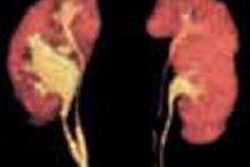
Radiologists must be familiar with the CT appearances of multifocal, renal solid tumors and tumor-like lesions so that clinicians and surgeons can determine the best approach for these patients, top award-winning Spanish researchers have asserted.
"Many hereditary syndromes associated with renal tumors have been described in the last two decades and new ones will probably be defined in the near future. Radiologists should be aware of these entities as they may initially guide the diagnosis," noted Dr. Miguel Ángel Corral de la Calle and colleagues from Servicio de Radiodiagnóstico, Complejo Asistencial de Ávila in Ávila, Spain, whose e-poster received one of only two prestigious magna cum laude awards handed out by judges at ECR 2016 in Vienna.
 Dr. Miguel Ángel Corral de la Calle from Ávila. Image courtesy of Agencia Iberoamericana para la Difusión de la Ciencia y la Tecnología.
Dr. Miguel Ángel Corral de la Calle from Ávila. Image courtesy of Agencia Iberoamericana para la Difusión de la Ciencia y la Tecnología.Clinical, radiological, and surgical clues can be crucial in patients with hereditary renal cancer syndromes, and it is important to bear in mind examples of presumably incidental coexistence of different histological subtypes of renal tumoral or pseudotumoral lesion, they added.
Multifocality refers to the existence of multiple renal lesions that may be unilateral or bilateral, either synchronic or metachronic, and bilaterality is present in 90% of cases, explained Corral de la Calle et al. Multifocal renal tumors account for around 2% to 4% of renal tumors in imaging studies, although they reach up to 25% in some autopsy series, due to small, clinically undetectable satellite lesions.
"When multiple renal tumors are found on an imaging study, the radiologist must evaluate the radiological behavior of each lesion and pertinent clinical features, including familiar antecedents, in order to achieve an optimal diagnostic approach. The possibility of a hereditary renal cancer syndrome has to be kept in mind in such cases," they pointed out.
Multidisciplinary approach
The value of percutaneous biopsy of the most representative lesion(s) helps find the best therapeutic approach and guiding genetic tests, and a multidisciplinary assessment involving urologists, nephrologists, oncologists, geneticists, and radiologists is necessary, the authors continued.
When surgery is indicated, a nephron-sparing approach is mandatory, especially in bilateral and hereditary cases, or if a patient only has a single kidney, the goal becomes to preserve as much renal function as possible with a satisfactory oncologic result. Percutaneous therapies can be of great interest, but the best technique and strategy depends on local preferences and the features of the specific case. Multiple metastases to one or both kidneys are the most frequent renal multifocal tumors.
The kidney is the eighth most common target of hematogenous metastatic spread, according to Corral de la Calle and colleagues. Renal metastases are radiologically evident in approximately 0.9% of patients with a malignant neoplasm, and a renal mass in a patient with nonrenal malignancy is nearly as likely to be an incidental primary renal tumor (0.6%) as a metastasis; renal metastases are as frequent as 7% to 20% in autopsy series.
"Tumors reported to more frequently metastasize to the kidney are lung, breast cancer, and melanoma, but renal metastases have also been described in many other malignancies, including from the contralateral kidney," they noted. "They commonly appear in the setting of advanced neoplastic disease, so that metastases are often present in different organs. In contrast to primary renal malignancies, metastases usually are infiltrating and ill-defined endophytic multiple (uni or bilateral) solid masses without cystic components."
Renal lymphoma
Renal and perirenal involvement in lymphoma commonly occurs in the setting of widespread nodal or extranodal lymphoma, either from direct or hematogenous spread, and is classified as secondary lymphoma, the authors wrote. It is most commonly seen in patients with non-Hodgkin lymphoma, usually the B-cell type or Burkitt lymphoma. Autopsy studies report an incidence as high as 30% to 60%, but the imaging manifestations are only seen in 1% to 8%, they continued.
"Renal lymphoma has a wide variety of manifestations, including diffuse infiltration of one or both kidneys (the most common finding at autopsy series), multiple lesions (the most common imaging appearance), a solitary lesion, direct extension from retroperitoneal adenopathy, and preferential involvement of the perinephric space. The lesions are most often bilateral but may also be unilateral," Corral de la Calle et al stated. "Parenchymal involvement manifests as ill-defined and poorly enhancing masses. Contrast between parenchyma and lesions is maximal at the nephrographic phase."
Concordant multifocality is more frequent among papillary renal cell carcinomas (approximately 10%), followed by clear cell renal carcinomas (2%) and chromophobe renal cell carcinomas (1.9%). Although some characteristics may overlap, there are some radiological clues that commonly allow a noninvasive diagnostic approach, they stated. Papillary renal cell carcinomas tend to be poorly enhancing cortical tumors. Cystic or hemorrhagic, rather than necrotic changes, are common, especially in type 2 tumors, and on MRI, they are usually hypointense on T2-weigthed images and show low apparent diffusion coefficient (ADC) values.
In general, clear cell renal carcinomas avidly enhance after intravenous contrast administration, often with unenhanced irregular necrotic areas, the authors wrote. Solid components are mildly hyperintense on T2 and necrotic regions are highly intense. ADC values, although variable, are commonly higher than in papillary renal cell carcinomas.
Chromophobe renal cell carcinomas usually are well-defined homogeneous tumors, but some heterogeneity may exist. The amount of contrast enhancement, as well as the MRI features, is variable. There is a wide range of benign to malign concordance from 49% to 95% in the literature, they explained. Moreover, histological concordance among different renal tumors varies from 57% to 93% in a different series.
Hereditary aspects
Hereditary renal cancer accounts for approximately 1% to 4% of renal cancer, Corral de la Calle and colleagues pointed out. Different genetic anomalies are characteristic of each condition, and they may cause cellular growth and neoangiogenesis in two ways that can interact: upregulation of the hypoxia-inducible factors, which are transcription factors that regulate a broad program of hypoxia-responsive genes, including vascular endothelial growth factor; and activation and dysregulation of mammalian target of rapamycin pathway. Many of these genetic anomalies are also present in sporadic renal tumors.
The most frequent inheritance pattern is autosomal-dominant, although there is a wide range of disparity among conditions, and renal cysts frequently coexist, they concluded.
To view the authors' clinical cases presented at ECR 2016, click here.




















